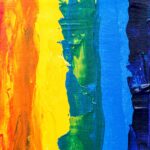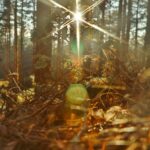by Johanna Linsingh
There is a big fat B in “LGBTQ+”, but as a bisexual person, I still often feel invisible or invalid. It’s like we are mythical creatures, an unfortunate status that is only reinforced by the fact that the act of looking for a bi girl to “spice things up”, as is frequently done by straight couples on dating apps, is referred to as “unicorn hunting”. But the proverbial sword is double edged, as even in fiction, bisexual people don’t really exist. Allow me to explain – and to illustrate.
Representation has been a buzzword for a few years now, and for good reason. Even though art is meant to imitate life, a lot of mainstream media fails to capture the true diversity of the world it is trying to recreate. Queer people have been starved of characters they can relate to for many years. Changes are happening: we’re seeing more and more gay characters in big TV shows and movies and we’re finally getting stories that are not just about coming to terms with their sexuality or coming out.
Here’s the kicker though: while I’ve seen a great deal of characters that feel like they are like me, it seems that the word “bisexual” does not exist in film and television. Furthermore, while these characters speak and act in a way that strongly implies that they are attracted to more than one gender, they rarely actually have any non-hetero romantic interactions. It’s frustrating, invalidating, and quite often it’s also a case of queerbaiting. A few examples.
Stiles Stilinski – Teen Wolf
Let’s get this out of the way first: Teen Wolf had quite a few queer characters throughout its run and always treated homosexuality as normal. My issue is not with representation in general, but rather the fact that 1. queer characters were always recurring cast, never main, and 2. one character in particular was very blatantly bi-coded, but this was never established in dialogue or in storyline.
The beloved Dylan O’Brien was part of Teen Wolf’s main cast for all 6 of its seasons and right off the bat, his character was shipped with his on-screen polar opposite, born werewolf Derek Hale. The writers were quick to catch on: while never establishing either of the characters as not-straight and giving both several female love interests, they also knew that there was a large portion of viewers that would keep coming back if there was just enough of a glimmer of hope that the two of them would end up together. Stiles and Derek frequently ended up in perilous situations together and had a handful of meaningful interactions, both verbal and physical, that they never had with other characters unless they were romantic interests.
The bi-coding of Stiles’ character obviously didn’t help. In one of Teen Wolf’s first episodes, he’s very concerned with whether or not he’s “attractive to gay guys”. The second season gets bolder and sees Stiles telling his best friend Scott that he’s attracted to him and asking if he wants to make out “just to see how it feels”. By the third season, Stiles kisses a girl that tells him she likes both girls and guys, and when she asks him whether he likes guys as well, we get a confused expression from Stiles and then the scene ends. The show’s writing very willingly left this question open ended, but never actually explored Stiles’ bisexuality. Possibly the worst part is that all of these scenes were supposed to be comedic, as if being bisexual or being attracted to the same gender is inherently hilarious.
Eleanor Shellstrop – The Good Place
I think we can all agree that The Good Place is a lovely show. The cast was racially diverse, the characters were fleshed out and unique and the writing was awesome. The show also ended before the storylines could get convoluted or overly complicated and ruin the quality of the comedy, as we’ve seen happen to many sitcoms. I loved The Good Place, beginning to end.
In fact, I hate criticizing it at all, and I know a lot of other queer people might not agree with me putting Eleanor Shellstrop on this list, but personally, the way her attraction to women was heavily emphasized on the show but never acted upon or explored in an actual storyline frustrated me. Eleanor, played by the amazing Kristen Bell, makes no secret of her attraction towards female and non-binary main characters like Tahani, Janet and Simone.
On a surface level, I do think it is lovely that the show treats this as normal. No one is ever shocked at these statements from Eleanor but, much like Teen Wolf, it is always worked into the plot as a comedic moment, making me wonder why Eleanor’s bisexuality is used as a joke.
I also want to stress that being unlabeled is perfectly valid. It’s just that characters actually calling themselves bisexual is so rare on television that I wish the writers had seen it through with this one, especially given the fact that Eleanor has a short rant about how it’s 2018 and more guys should be bi, and that they had given her a fleshed out storyline with a woman or non-binary character. In fact, the show is written in a way that there are multiple resets where the characters start all over again in a new universe with their memories wiped, so having Eleanor be with a woman or a non-binary person in one of these universes would have been perfectly possible and would have so many bi and pan people happy.
Steve Rogers – Marvel Cinematic Universe
Steve Rogers was a bisexual man and that is a hill I will die on. Bucky Barnes is gay, by the way, but that is a conversation for a different time. We know representation is an issue with the MCU. Most of its titular characters have been white, male, straight and cisgender. The release of Black Panther in 2018 was a huge step forward, and more recently, The Falcon and The Winter Soldier on Disney+ made racial inequality a central plot point throughout the series, carried by an incredible performance from Anthony Mackie. Also on Disney+, it has finally been confirmed that Loki is gender fluid and bisexual.
While it makes me very happy to see that on my screen, I can’t help but notice Disney didn’t choose to do this back when they were releasing major blockbusters that were reaching worldwide audiences and that had to make them a great deal of money. Disney cashed in on stories about white, straight, cisgender men before ever venturing into the riskier territory of queer representation. Characters like Carol Danvers and Valkyrie, for example, were quite obviously queer to a lot of queer people, but this was hidden enough in subtext that conservative audiences would never notice.
The same goes for Steve Rogers. On a surface level, we see Chris Evans play a man who never stopped loving Peggy Carter, and who even had a brief fling with her niece (seriously, why, Marvel). However, there is one other person in Steve’s life that is just as important to him as Peggy is, and that is his best friend Bucky Barnes. In fact, he loves Bucky so much that he impulsively goes behind enemy lines to fight hordes of heavily armed men, on the off chance that Bucky might still be alive out there somewhere. Decades later, Steve shows that he would rather die at his best friend’s hands than live in a world where Bucky doesn’t remember him. Fast forward a couple of years again, and we see Steve break multiple international laws and treaties, which goes against his very nature at that point, just to save Bucky’s life.
It’s not just Steve’s bond with Bucky, by the way. I can totally accept the fact that we can have this type of deep platonic love with people and I think it’s very important that we represent male friendships that are emotional and unconditional. However, Steve’s bisexuality was solidified in my mind during the opening scene of Captain America: The Winter Soldier. It’s the scene where he first meets Sam and I can guarantee you, had the scene been exactly the same, but with Sam as a woman, we would all read it as flirting. Because the entire playful, giggly and sparkly eyed exchange is flirting. I always read it as Steve testing the waters as to how acceptable it is to flirt with men in this century and seeing what he could get away with.
That concludes my brief dive into characters that I wish screenwriters had actually called bisexual. The slow but steady normalisation of same gender attraction and multiple gender attraction in works of fiction is a positive development, but as it stands, it still seems that bisexuality and pansexuality are not seen as real or valid sexual orientations, as writers still shy away from those terms.
Johanna Linsingh is a bisexual person with she/they pronouns (they’re still figuring that one out). She came out as bi 5 years ago and has been hoping to see more bi representation ever since. You can follow her on Instagram @johannalinsingh or on TikTok @twenty.something.



Add your first comment to this post